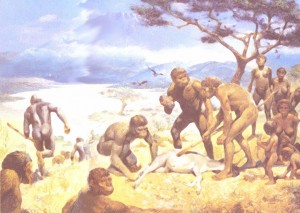Current Anthropology Special Issue: Human Biology and the Origins of Homo

We are pleased to announce the publication of Human Biology and the Origins of Homo. This is the sixth in the open access Current Anthropology Supplementary Series on big questions in the field of anthropology – and the origin of Homo is currently one of the biggest questions in hominin paleontology.
This CA supplementary issue resulted from a Wenner-Gren Symposium organized by Susan C. Antón (New York University) and Leslie C. Aiello (Wenner-Gren Foundation) held March 4–11, 2011, at the Tivoli Palácio de Seteais in Sintra, Portugal.
Although Homo erectus has been known since the 1890s and Homo habilis was announced almost 50 years ago, new fossil discoveries in the last decade have complicated our understanding of early Homo and challenged our long-held assumptions about its similarities and differences to the australopiths as well as to later members of our genus. This necessarily influences our interpretations for the origin and evolution of Homo and also highlights the need for a new framework for interpretation of the hard evidence.
Human Biology and the Origins of Homo assesses what is currently known about the fossil evidence and the environmental context of early Homo and sets the stage for integrated, multidisciplinary studies to provide a framework for interpretation of the hard evidence. Contributors to the supplementary issue include paleoanthropologists, human biologists, behavorialists, and modelers. The basic idea behind this collection of papers is the necessity to have a solid understanding of how and why modern humans and other animals vary in order to understand the adaptive shifts involved with the evolution of Homo.
Human Biology and the Origins of Homo is introduced by Aiello and Antón, who summarize the current state of our knowledge about the origin of Homo, integrate the varied contributions, and give a taste of the potential that this approach has for human evolution. There are 15 additional papers in the collection that establish who early Homo is and the archaeological and environmental context of the genus as well as looking in detail at topics ranging from diet, to energetics, to body size and proportions, to growth and development, to brain evolution and much more. The concluding paper by Antón and Snodgrass draws from the wealth of ideas in this collection and provides a fresh perspective on three important shifts in human evolutionary history: (1) the emergence of Homo; (2) the transition between non-erectus early Homo and H. erectus; and (3) the appearance of regional variation in H. erectus. It concludes with a new positive feedback model for the origin and evolution of Homo that involves critical elements such as cooperative breeding, changes in diet, body composition, and extrinsic mortality risk that drive life history.
The papers included in this supplementary issue are all open access. We hope that you find the ideas presented in them as interesting and engaging as we did during the symposium and the production of this CA issue.
Table of Contents
Introductions to the supplementary issue and to the papers it contains
- Aiello, Leslie C. – Human Biology and the Origin of Homo: Wenner-Gren Symposium Supplement 6
- Aiello, Leslie C. and Susan C. Antón. Human biology and the origin of Homo: An Introduction to Supplement 6.
Setting the Stage
- Antón, Susan C. Early Homo: Who, When, and Where.
- Potts, Richard. Environmental and Behavioral Evidence Pertaining to the Evolution of early Homo.
Food, Morphology and Locomotion
- Ungar, Peter. Dental Evidence for the Reconstruction of Diet in African Early Homo.
- Holliday, Trenton W. Body Size, Body Shape, and the Circumscription of the Genus Homo.
- Pontzer, Herman. Ecological Energetics in Early Homo.
Body Size and Growth
- Migliano, Andrea Bamberg and Myrtille Guillon. The Effects of Mortality, Subsistence and Ecology on Human Adult Height and Implications for Homo Evolution.
- Kuzawa, Christopher W and Jared M Bragg Plasticity in Human Life History Strategy: Implications For Contemporary Human Variation and the Evolution of the Genus Homo.
- Pfeiffer, Susan. Conditions for Evolution of Small Adult Body Size in Southern Africa.
- Schwartz, Gary T. Growth, Development, and Life History throughout the Evolution of Homo.
- Plavcan, J. Michael. Body Size, Size Variation, and Sexual Size Dimorphism.
- Bribiescas, Richard G., Peter T. Ellison, Peter B. Gray. Male life history, reproductive effort, and the evolution of the genus Homo.
Models for cooperation, sociality, life history, body size and brain size
- Smith, Jennifer E., Eli M. Swanson, Daphna Reed, and Kay E. Holekamp. Evolution of Cooperation among Mammalian Carnivores and Its Relevance to Hominin Evolution.
- Isler, Karin and Carel P. van Schaik. How our Ancestors broke through the Gray Ceiling: Comparative Evidence for Cooperative Breeding in Early Homo.
- Wells, Jonathan CK. The Capital Economy in Hominin Evolution: How Adipose Tissue and Social Relationships Confer Phenotypic Flexibility and Resilience in Stochastic Environments.
New Perspectives on the evolution of Homo
- Antón, Susan C. and J. Josh Snodgrass. Origin and evolution of genus Homo: new perspectives.
Current Anthropology, published by The University of Chicago Press on behalf of the Wenner-Gren Foundation for Anthropological Research, is a transnational journal devoted to research on humankind, encompassing the full range of anthropological scholarship on human cultures and on the human and other primate species. Twice a year, special supplemental issues composed of papers resulting from Wenner-Gren symposia are published and made available as open access.